 Dealing with lumbar and upper back pain can be incredibly disruptive, especially for those dedicated to sports rehabilitation where peak physical condition is paramount. From my years of experience, I've observed that chronic pain rarely succumbs to a single solution. Instead, a multi-modal treatment approach, combining various techniques, often yields the most significant and lasting relief. This article will explore five key methods you can integrate into your routine, including the strategic use of a quality lumbar massager, to help manage and alleviate this persistent discomfort. We'll look at how combining active recovery with targeted therapies can enhance your rehabilitation journey.
Dealing with lumbar and upper back pain can be incredibly disruptive, especially for those dedicated to sports rehabilitation where peak physical condition is paramount. From my years of experience, I've observed that chronic pain rarely succumbs to a single solution. Instead, a multi-modal treatment approach, combining various techniques, often yields the most significant and lasting relief. This article will explore five key methods you can integrate into your routine, including the strategic use of a quality lumbar massager, to help manage and alleviate this persistent discomfort. We'll look at how combining active recovery with targeted therapies can enhance your rehabilitation journey.
The aim is to empower you with practical, actionable strategies. For those in sports rehabilitation, understanding how to effectively manage pain not only aids recovery but also helps prevent re-injury. We'll delve into how these methods can work synergistically, providing a more comprehensive path to feeling better and getting back to your activities with confidence. This is about finding what truly works for your body.
1. Targeted Stretching & Mobility Work
One of the foundational pillars for managing back pain, particularly in sports rehabilitation, is consistent, targeted stretching and mobility work (Perspective 1). Tight muscles, especially in the hips, hamstrings, and thoracic spine, can significantly contribute to both lumbar and upper back pain by altering biomechanics and placing undue stress on these areas. Gentle, sustained stretches help to improve flexibility, reduce muscle tension, and restore a more natural range of motion. Think of your muscles as bands; if they are too tight, they pull on their anchor points, causing discomfort.
How to Perform:
- Cat-Cow Stretch: Start on all fours. As you inhale, drop your belly, arch your back, and look up (Cow). As you exhale, round your spine towards the ceiling, tucking your chin to your chest (Cat). Repeat 10-15 times.
- Piriformis Stretch: Lie on your back with knees bent. Cross one ankle over the opposite knee. Gently pull the uncrossed leg towards your chest until you feel a stretch in the buttock of the crossed leg. Hold for 30 seconds, repeat on the other side.
- Thoracic Extension over Foam Roller: Lie with a foam roller horizontally under your upper back. Support your head with your hands. Gently extend your upper back over the roller, then return to the start. Move the roller slightly up or down to target different areas.
Benefits/Tips:
- Improves flexibility and reduces muscle stiffness.
- Enhances blood flow to tight areas, promoting healing.
- For sports rehabilitation, focus on dynamic stretches before activity and static stretches after.
- Always move slowly and avoid bouncing; listen to your body and don't push into sharp pain.
2. Self-Myofascial Release (SMR) with Tools
Self-myofascial release involves applying pressure to tight spots or trigger points in your muscles to help them relax and release. This can be done with various tools, from simple tennis balls to more specialized foam rollers or massage sticks. For athletes in rehabilitation, SMR can be particularly beneficial for breaking up adhesions and improving tissue quality, which might have been compromised due to injury or overuse. It’s like giving yourself a targeted deep-tissue massage to work out the kinks.
Regular SMR can complement stretching by addressing deeper restrictions in the fascia, the connective tissue that envelops your muscles. This technique can be a really, really effective way to manage day-to-day muscle soreness and maintain pliability, helping to prevent minor issues from escalating into more significant pain problems. Consider it an essential part of your recovery toolkit.
How to Perform:
- Glute Release with Lacrosse Ball: Sit on the floor and place a lacrosse ball under one glute. Support yourself with your hands and gently roll over the ball, searching for tender spots. When you find one, pause and hold for 20-30 seconds.
- Upper Back Release with Foam Roller: Lie on your back with a foam roller placed horizontally under your shoulder blades. Lift your hips slightly and use your legs to roll up and down your upper back, avoiding the neck and lower back directly.
Benefits/Tips:
- Reduces muscle soreness and improves recovery time.
- Increases blood flow and helps release trigger points.
- Can improve range of motion when performed before stretching or activity.
- Start gently, as SMR can be intense. Breathe deeply throughout.
3. Leveraging a Multi-Functional Lumbar Massager
 Modern technology has brought sophisticated tools into our homes, and a high-quality multi-functional lumbar massager can be a significant asset in managing back pain, echoing Perspective 3. Devices like the Klcosy lumbar massager are designed with features that aim to provide comprehensive relief. Many users find that an adjustable intensity massager for lower back pain allows them to customize the treatment to their specific needs and tolerance levels, which is crucial during different phases of sports rehabilitation. This means you can start gently post-injury and gradually increase intensity as you heal.
Modern technology has brought sophisticated tools into our homes, and a high-quality multi-functional lumbar massager can be a significant asset in managing back pain, echoing Perspective 3. Devices like the Klcosy lumbar massager are designed with features that aim to provide comprehensive relief. Many users find that an adjustable intensity massager for lower back pain allows them to customize the treatment to their specific needs and tolerance levels, which is crucial during different phases of sports rehabilitation. This means you can start gently post-injury and gradually increase intensity as you heal.
The combination of modalities is where these devices often shine. For instance, a heat vibration combo for hip and lumbar relief can be particularly effective. Heat helps to relax tight muscles and increase blood flow, while vibration can soothe soreness and further promote relaxation. Some advanced models may even incorporate features like red light therapy; while specific research on does Klcosy red light therapy actually reduce inflammation is ongoing and individual results can vary, some users report benefits. The key is finding a device that offers functions relevant to your pain type. Positive Klcosy massager long-term back pain reduction results are often linked to consistent use and integration with other recovery methods.
How to Utilize:
- Targeted Application: Position the lumbar massager on the affected area of your lower or upper back, or even hips/glutes if these contribute to your back pain.
- Adjust Settings: Start with lower intensity and shorter durations (e.g., 10-15 minutes). Utilize features like heat if available and comfortable. Gradually adjust based on your comfort and perceived benefit.
- Consistent Use: Incorporate into your daily or several-times-a-week routine, perhaps post-workout or before bed, for sustained benefits.
Benefits/Tips:
- Provides convenient, on-demand relief from muscle tension and soreness.
- Features like adjustable intensity and heat enhance muscle relaxation and blood flow.
- Can be a valuable tool for managing pain between professional therapy sessions.
- Always follow manufacturer guidelines for your specific lumbar massager.
- If you have underlying conditions, consult a healthcare professional before use.
4. Core Strengthening Exercises
A strong, stable core is fundamental for a healthy back, especially in sports rehabilitation. The core muscles – including abdominals, obliques, and deep spinal muscles – act as a natural corset, supporting the spine and reducing the load on your lumbar and upper back. Weak core muscles can lead to poor posture, increased strain on spinal structures, and a higher risk of injury. Integrating specific core strengthening exercises into your routine can make a world of difference in your long-term back health.
It's important to focus on exercises that engage the deep core muscles correctly, rather than just superficial ones. Proper form is paramount to avoid further strain. These exercises aren’t about getting a six-pack; they are about building functional strength that protects your spine during movement and activity. This active approach is a vital complement to passive treatments like massage.
How to Perform:
- Plank: Start in a push-up position, then lower onto your forearms. Keep your body in a straight line from head to heels, engaging your core. Hold for 20-60 seconds, gradually increasing duration.
- Bird-Dog: Start on all fours. Extend one arm straight forward and the opposite leg straight back, keeping your core engaged and back flat. Hold for a few seconds, then slowly return. Repeat on the other side.
- Dead Bug: Lie on your back with arms extended towards the ceiling and knees bent at 90 degrees over your hips. Slowly lower one arm towards the floor behind your head while extending the opposite leg towards the floor. Keep your lower back pressed into the floor. Return to start and repeat on the other side.
Benefits/Tips:
- Improves spinal stability and support.
- Reduces strain on back muscles and ligaments.
- Helps improve posture and balance.
- Focus on quality of movement over quantity. Engage your core throughout each exercise.
5. Professional Manual Therapy
While self-care strategies are invaluable, there are times when professional intervention is necessary, particularly for severe or persistent pain (Perspective 2). A skilled physiotherapist, chiropractor, or massage therapist can provide targeted treatments that may be difficult to achieve on your own. They can perform detailed assessments to identify the root cause of your pain and apply specific manual techniques like joint mobilization, soft tissue release, or therapeutic massage. This is especially true in sports rehabilitation where an accurate diagnosis is key.
Professional therapists can also guide your rehabilitation, ensuring you're performing exercises correctly and progressing safely. They might use modalities beyond manual techniques, such as dry needling or electrotherapy, depending on your condition. The discussion around Klcosy vs professional PT for chronic lumbar issues often concludes that these approaches are not mutually exclusive but can be complementary. A device might help manage symptoms between professional sessions, but a PT offers diagnostic expertise and personalized treatment plans.
What to Expect:
- Assessment: A thorough evaluation of your posture, movement patterns, and pain.
- Manual Techniques: Hands-on treatment like massage, joint mobilization, or trigger point therapy.
- Personalized Exercise Prescription: Specific exercises tailored to your condition and goals.
- Education: Guidance on pain management, injury prevention, and ergonomics.
Benefits/Tips:
- Accurate diagnosis and targeted treatment for underlying issues.
- Relief from severe or persistent pain that doesn't respond to self-care.
- Personalized rehabilitation plan and guidance.
- Can address complex issues that require specialized skills.
Tips for Holistic Back Care in Sports Rehabilitation
Managing lumbar and upper back pain effectively, especially during sports rehabilitation, requires a holistic view. It's not just about treating the pain when it flares up but about creating a supportive environment for your back. This means paying attention to your body's signals and being proactive. Consistency with your chosen relief methods is key; sporadic efforts rarely yield long-term results. Integrate these practices into your regular routine, much like you would your sport-specific training.
Proper warm-ups before any activity and cool-downs afterward are crucial. Ensure your training techniques are correct to avoid undue strain. Listen to your body – don’t push through sharp or increasing pain, as this can worsen an injury. Adequate rest and recovery are just as important as the active components of rehabilitation. And finally, consider your overall lifestyle: hydration, nutrition, and stress management all play a role in how your body heals and copes with physical demands. This multi-modal approach truly makes a difference.
- Consistency is Key: Regular application of stretches, exercises, and massager use.
- Proper Form: In all exercises and daily activities to prevent strain.
- Warm-up and Cool-down: Essential before and after physical activity.
- Listen to Your Body: Differentiate between muscle soreness and pain signals.
- Hydration and Nutrition: Support tissue health and recovery.
- Ergonomics: Pay attention to your posture during daily activities, not just exercise.
Important Note: When to Seek Professional Help
While the methods discussed can be very effective for managing many types of lumbar and upper back pain, it's crucial to recognize when self-care isn't enough, or when professional guidance is needed from the outset. If your pain is severe, came on suddenly after an injury, doesn't improve with self-care after a reasonable period (e.g., 1-2 weeks), or is accompanied by "red flag" symptoms, you should seek immediate consultation with a doctor or physiotherapist. This aligns with Perspective 2, emphasizing that professional intervention is irreplaceable in certain situations.
Red flag symptoms include, but are not limited to: pain radiating down your leg below the knee, numbness or tingling in your legs or feet, weakness in your legs, loss of bladder or bowel control, unexplained weight loss, or fever. These could indicate a more serious underlying condition that requires medical diagnosis and treatment. For athletes in rehabilitation, working closely with a sports physiotherapist is generally recommended to ensure a safe and effective return to sport. They can help determine if tools like a lumbar massager are appropriate for your specific injury phase or if professional therapy is the primary need when considering Klcosy vs professional PT for chronic lumbar issues.
- Pain is severe and debilitating.
- Pain resulted from a significant trauma or injury.
- Pain is worsening despite self-care efforts.
- Presence of numbness, tingling, or weakness in the limbs.
- Changes in bladder or bowel function.
- Pain accompanied by fever or unexplained weight loss.
Conclusion: An Integrated Path to Back Pain Relief
Effectively managing lumbar and upper back pain, especially within a sports rehabilitation context, truly benefits from a multi-modal approach. Combining active strategies like targeted stretching and core strengthening with supportive therapies such as self-myofascial release, the use of a versatile lumbar massager, and professional manual therapy when needed, creates a powerful synergy. From my perspective, integrating traditional understandings of body mechanics with modern innovations like an intelligent lumbar massager can offer profound benefits.
Remember that consistency and listening to your body are paramount. No single method is a magic bullet, but by thoughtfully combining these approaches, you can significantly enhance your recovery, reduce pain, and improve your overall back health. This empowers you to take an active role in your well-being and get back to performing at your best.
Frequently Asked Questions (FAQ)
Can Klcosy massagers replace chiropractic care for spinal misalignment?
While a Klcosy lumbar massager can be very effective for relieving muscle tension, improving circulation, and providing pain relief around the spine, it is generally not designed to correct structural spinal misalignments in the way chiropractic care aims to. Chiropractic adjustments are specific manipulations performed by a trained professional to restore joint mobility and alignment. A massager works primarily on soft tissues. They can be complementary; a massager might help relax muscles, making adjustments easier or more effective, but it's unlikely to replace the specific diagnostic and manipulative functions of a chiropractor for diagnosed misalignments.
How often should I use Klcosy to avoid muscle dependency?
To avoid muscle dependency on any massager, including a Klcosy lumbar massager, it's best used as a tool to aid recovery and manage symptoms, not as a replacement for active strengthening and stretching. For general relief or post-exercise recovery, using it 3-5 times a week for 15-30 minute sessions is often a good starting point. Listen to your body. If you feel your muscles are becoming "reliant" or you neglect active care, reduce frequency. The goal is for the massager to help your muscles function better on their own, not to become a crutch. An adjustable intensity massager for lower back pain like Klcosy allows you to vary the treatment, which can also help prevent adaptation.
Is Klcosy safe for disc herniation patients?
This is a critical question where caution is paramount. If you have a diagnosed disc herniation, you *must* consult your doctor or physiotherapist before using any lumbar massager, including a Klcosy. In some acute phases or depending on the type and location of the herniation, direct pressure or vibration could potentially aggravate the condition. However, in other cases, gentle heat or light massage to surrounding tight muscles (not directly on the herniation site) might be deemed acceptable or even beneficial by a professional. Never self-treat a disc herniation with a massager without explicit medical approval and guidance.
Do massages help upper back pain?
Yes, massages, including those from a lumbar massager that can be applied to the upper back, can definitely help relieve upper back pain, especially if it's caused by muscle tension, knots (trigger points), poor posture, or overuse. Massage helps by increasing blood flow to the area, relaxing tight muscles, improving flexibility, and reducing pain perception. Whether it's from a professional therapist or a good quality massager using, for example, a heat vibration combo for hip and lumbar relief (which can often be adapted for upper back use), many people find significant relief for common upper back discomfort.
This reply is generated based on currently verifiable public information and general knowledge. The information provided is for general informational purposes only and does not constitute medical advice. It is recommended to cross-check key content with authoritative sources and consult with a qualified healthcare professional for any health concerns or before making any decisions related to your health or treatment, especially if you are undergoing sports rehabilitation or have pre-existing conditions.




0 comments